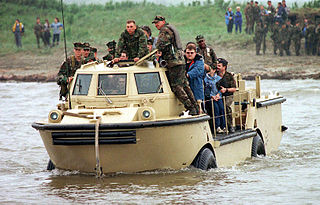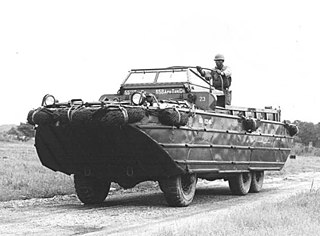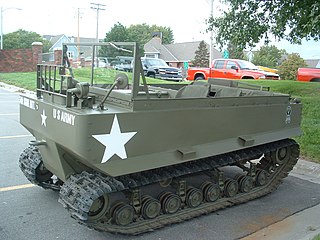
Walcheren is a region and former island in the Dutch province of Zeeland at the mouth of the Scheldt estuary. It lies between the Eastern Scheldt in the north and the Western Scheldt in the south and is roughly the shape of a rhombus. The two sides facing the North Sea consist of dunes and the rest of its coastline is made up of dykes. Middelburg, the provincial capital, lies at Walcheren's centre. Vlissingen, 9 kilometres (5.6 mi) to the south, is the main harbour and the third municipality is Veere.

The Volkswagen Schwimmwagen was a four-wheel drive amphibious vehicle, used extensively by German ground forces during the Second World War. The Schwimmwagen is the most numerous mass-produced amphibious car in history.

An amphibious vehicle, is a vehicle that is a means of transport viable on land as well as on or under water. Amphibious vehicles include amphibious bicycles, ATVs, cars, buses, trucks, railway vehicles, combat vehicles and hovercraft.

Landing craft are small and medium seagoing watercraft, such as boats and barges, used to convey a landing force from the sea to the shore during an amphibious assault. The term excludes landing ships, which are larger. Production of landing craft peaked during World War II, with a significant number of different designs produced in large quantities by the United Kingdom and United States.

A half-track is a civilian or military vehicle with regular wheels at the front for steering and continuous tracks at the back to propel the vehicle and carry most of the load. The purpose of this combination is to produce a vehicle with the cross-country capabilities of a tank and the handling of a wheeled vehicle.

The Amphibious Vehicle, Tracked (LVT) is an amphibious warfare vehicle and amphibious landing craft, introduced by the United States Navy and United States Marine Corps. The United States Army, Canadian Army and British Army used several LVT models during World War II, and referred to those vehicles as "Landing Vehicle, Tracked."

The DUKW is a six-wheel-drive amphibious modification of the 2+1⁄2-ton CCKW trucks used by the U.S. military during World War II and the Korean War.

The Battle of the Scheldt in World War II was a series of military operations led by the First Canadian Army, with Canadian, Polish and British units attached, to open up the shipping route to Antwerp so that its port could be used to supply the Allies in north-west Europe. Under acting command of the First Canadian's Lieutenant-General Guy Simonds, the battle took place in northern Belgium and southwestern Netherlands from 2 October to 8 November, 1944.

The M29 Weasel was a World War II tracked vehicle, built by Studebaker, designed for operation in snow.

The Willys MB and the Ford GPW, both formally called the U.S. Army Truck, 1⁄4-ton, 4×4, Command Reconnaissance, commonly known as the Willys Jeep, Jeep, or jeep, and sometimes referred to by its supply catalogue designation G503, were highly successful American off-road capable light military utility vehicles built in large numbers to a standardized design for the United States and other Allied forces in World War II from 1941 to 1945.

The Ford GPA 'Seep' was an amphibious version of the World War II Ford GPW jeep. Unlike the jeep, the seep was not a successful design; it was considered too slow and heavy on land, and lacked sufficient seagoing abilities in open water. The design features of the much larger and more successful DUKW amphibious truck were used on the GPA.

The GAZ-46, army designation MAV, is a Russian-made light four-wheel drive amphibious military vehicle that entered service in the 1950s and has been used by many Eastern Bloc allied forces since. During the Second World War Canada, Britain and the US forwarded large quantities of military materials to Russia. Among those were jeeps, trucks, and amphibious vehicles like the 6×6 DUKW and the 4×4 Ford GPA. The latter were used to help men and equipment get across the many rivers of Eastern Europe and combat the Germans. Seeing merits of such vehicles, after the war, Russia decided to develop two similar vehicles, using domestic automotive parts, the BAV, an equivalent of the DUKW, and the MAV, an equivalent of the Ford GPA.

The M520 "Truck, Cargo, 8-ton, 4x4", nicknamed Goer, truck series was formerly the US Army’s standard heavy tactical truck before its replacement by the Oshkosh HEMTT. As trucks go, the Caterpillar-made Goer stands out due to being articulated, much wider than other trucks, and lacking suspension on the wheels.

The PTS is a Soviet tracked amphibious transport. PTS stands for Plavayushchij Transportyer - Sryednyj or medium amphibious transport vehicle. Its industrial index was Ob'yekt 65.

An amphibious warfare ship is an amphibious vehicle warship employed to land and support ground forces, such as marines, on enemy territory during an amphibious assault.

The GMC CCKW, also known as "Jimmy", or the G-508 by its Ordnance Supply Catalog nr, was a highly successful series of off-road capable, 21⁄2-ton, 6×6 trucks, built in large numbers to a standardized design for the U.S. Army, that saw heavy service, predominantly as cargo trucks, in both World War II and the Korean War. The original "Deuce and a Half", it formed the backbone of the famed Red Ball Express that kept Allied armies supplied as they pushed eastward after the Normandy invasion.

The Amphibious Truck "Su-Ki" was a World War II Japanese military vehicle manufactured by the Toyota Motor Co., Ltd. It entered service in 1943 and was used by Japanese forces in the Pacific during World War II. A total of 198 Su-Ki trucks were produced.
The K-38 splicer's trailer was used in World War II for carrying telephone cable splicers tools in the field.

The Dodge WC series, sometimes nicknamed 'Beeps', were a prolific range of light 4WD and medium 6WD military utility trucks, produced by Dodge / Fargo during World War II. Together with the 1⁄4-ton jeeps produced by Willys and Ford, the Dodge 1⁄2‑tons and 3⁄4‑tons made up nearly all of the light 4WD trucks supplied to the U.S. military in WWII – with Dodge contributing some 337,500 4WD units.

An amphibious automobile is an automobile that is a means of transport viable on land as well as on or under water. They are unarmored for civilian use.




















